Menu
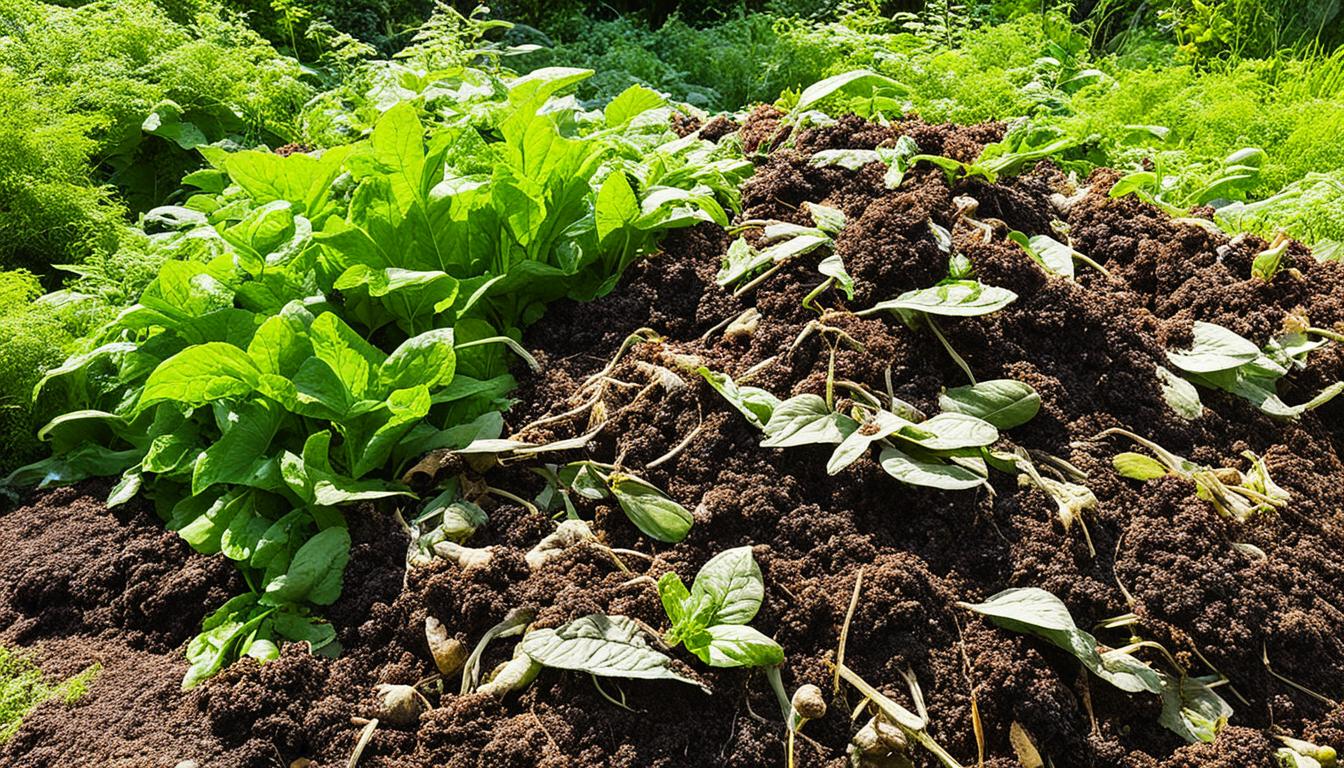
Did you know Mt. Cuba Center watches over their compost piles’ temperatures? They keep them between 131 and 165 degrees Fahrenheit. This helps ensure the compost is of the best quality for the garden soil. I follow these careful steps to improve soil health for strong plant growth all year round.
Our farm truly values composting in our everyday garden care. We spread our own compost on the garden beds to get rich harvests. Compost is full of nutrients. It helps make the soil better, lets air in, and holds water well. These are all vital for a healthy garden.
Compost doesn’t just feed the soil. It creates a home for good bugs, worms, and tiny fungi. These all help make the soil healthy and rich. Composting means we recycle waste into something valuable for the soil. It’s a green way to keep the garden strong for plants to thrive. For more about how compost helps the soil, check out compost as a soil amendment.
Composting is key for more than just managing waste. It’s vital for enriching the soil. It lessens waste going to landfills and cuts down on greenhouse gases. The U.S. EPA found that food scraps and garden waste form over 28 percent of household waste. This shows the need for better ways to deal with waste.
Composting is valuable because it makes nutrient-rich compost. This compost helps plants grow better, boosting garden productivity. It also brings various organisms that help balance and strengthen the ecosystem.
Composting greatly boosts soil and garden health. Research shows soil can hold up to 20,000 more gallons of water for each one percent increase in organic matter. Nutrient-rich compost encourages good microorganisms, creating a fertile environment for growth.
Composting is about more than waste management. It’s about actively enriching the soil in a natural way. This process ensures our gardens do well. The positive effects of composting touch many areas, from garden growth to waste reduction and ecosystem balance.
Creating good compost is all about the right mix of materials. You need a mix of kitchen scraps and yard waste. This mix creates the perfect environment for turning waste into valuable organic matter in compost.
A family of four in America throws away about $150 of food each month. By turning this into compost, we recycle important nutrients. This also helps cut down on landfill waste and lower costs. Nearly 28% of our trash is made up of food and garden waste, says the U.S. Environmental Protection Agency.
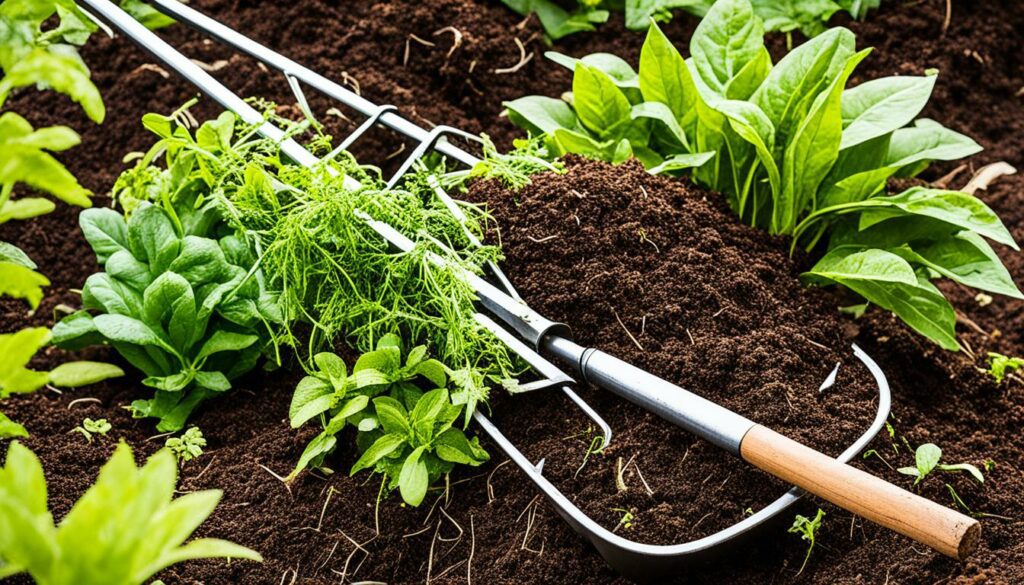
It’s important to get the carbon-to-nitrogen ratio right for good compost. You want about 25 to 30 times more carbon than nitrogen. For carbon, use items like dry leaves, wood chips, and newspaper. For nitrogen, use things including fruit and veg scraps, and coffee grounds. This balance stops the pile from getting too hot or cold, which helps it decompose properly.
Hot composting makes useable compost in one to three months. Cold composting takes longer, about one to two years. Turning the compost regularly helps speed things up. San Francisco has shown how effective this can be. They’ve cut down on landfill waste by more than 80% since 2012, a great model for others to follow.
Avoid putting meat, cheese, fats, pets waste, or treated wood in the compost. These things can attract pests and slow down the composting. Stick to the best practices by using the right mix of kitchen scraps and yard waste. This will make strong compost that’s good for the soil and plants.
Learning how to start composting is key to success. It all starts with picking the right spot for your compost pile. The perfect ideal compost pile location should help your compost break down well.
Your compost needs plenty of airflow and sunlight to decompose properly. A location that’s well-aired stops bad smells and encourages healthy composting. The sun’s warmth also speeds up the process without making it too dry.
Choosing a spot that’s easy to access is important too. Placing the pile close to your garden makes moving compost to your plants easier. This saves time and effort. It also makes turning the pile more convenient for even composting.
Selecting the right spot is crucial for effective composting. Consider airflow and sunlight, convenience, and the practical side. This ensures a successful journey with composting.
Keeping the compost at the right temperature is crucial for its health. If it’s too cold, under 135°F, bad bugs and flies can live there. But if it gets too hot, over 160°F, helpful organisms might not work well.
Around 150°F is the sweet spot to aim for. This temperature helps good bacteria work to kill bad seeds and bugs. It’s best to use a good thermometer, like the RT610B, to check the temperature. It keeps track of highs and lows, helping you keep things just right.
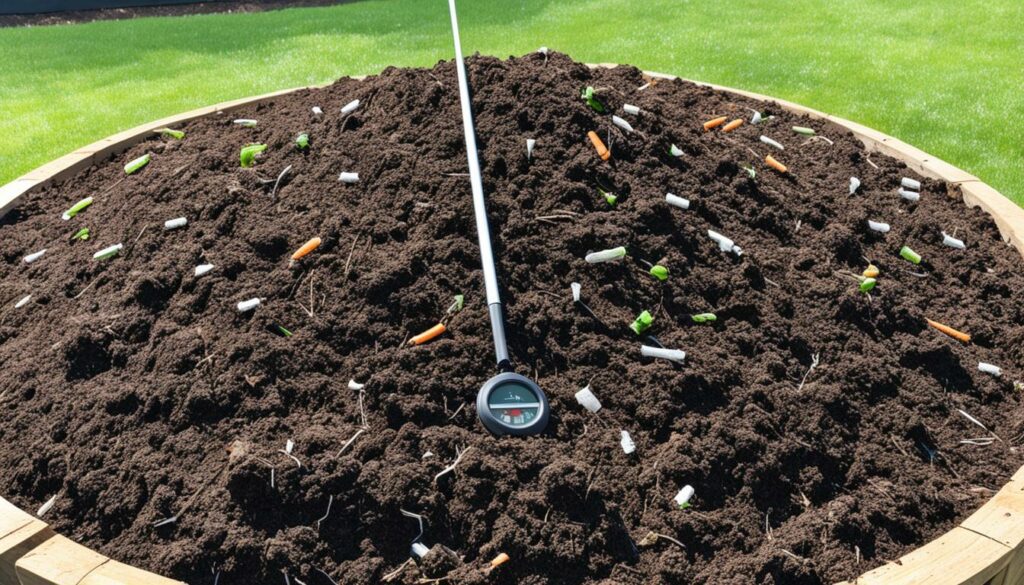
Once the compost reaches the right temperature, you can get good compost in 4-6 months. It’s also key to keep the moisture level balanced. Mixing dried leaves and grass in a 4-to-1 ratio helps in staying warm inside.
| Temperature (°F) | Implications |
|---|---|
| Below 135°F | Parasite eggs, cysts, and flies may survive. |
| 135°F – 160°F | Optimal range for destroying unwanted seeds and pathogens while maintaining beneficial biological activity in compost. |
| Above 160°F | Activity of thermophilic organisms is inhibited. |
Choosing a thermometer like the RT610B means you can keep a close eye on things for a long time, up to 5,000 hours. This, along with watching the moisture and adding the right mix of leaves and grass, will help you make top-notch compost. Good compost means good soil and plants.
Turning your compost pile is key to good composting. It keeps the heat even and lets helpful tiny creatures breathe. This way, you get nutrient-rich compost for your garden.
Regularly turning your compost has big pluses. It helps heat everything up, which is needed to kill weed seeds and bugs. This step also keeps the oxygen flowing for the good bacteria.
Turning helps air and water move well in your compost. It makes sure the materials break down evenly. With lots of our waste being compostable, this method is great for the earth.
Consider the statistics:
Turn your compost every few days or use special bins for better airflow. Tools like bucket loaders or piles with aeration tubes can help. These methods improve how well and quickly your compost works.
By turning your compost, you change waste into something that boosts your garden. This also helps the planet in a small but important way.
Composting does more than help the environment. It’s a key way to make soil strong. I’ve seen how compost boosts natural plant growth. It creates soil that’s perfect for growing healthier crops.
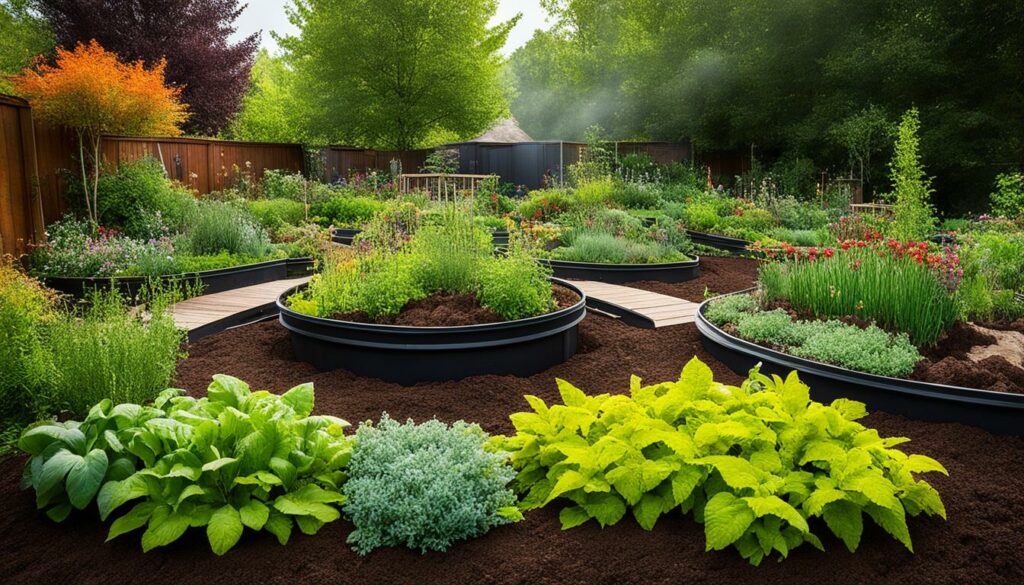
Between 2011 and 2016, Washington State University showed how great composting is in Snohomish county. It taught folks there about composting. This knowledge led to better soil and more crops. My work has also shown that natural compost is better than man-made stuff. In 2015, many farmers (62%) chose to keep using compost. They saw how great it is for the earth and their plants.
From 2017-2019, WSU found that places using compost for crops like raspberries and vegetables did better. This shows that compost is a solid choice over fertilizers for certain plants.
One big tip for composting is keeping it warm. The best heat is between 130-165 F for three days. This heat kills bad stuff and weed seeds. It makes compost safe for plants. Also, the right amount of carbon compared to nitrogen, from 20:1 to 40:1, is key for good compost. This mix helps keep the soil strong and healthy.
From monitoring temperature to regulating the carbon-to-nitrogen ratio, each step in the composting process plays a crucial role in fostering soil health.
The EPA says over a quarter of America’s waste is food and garden bits. By composting this waste, we avoid filling landfills. This is good for the earth. It also makes soil better at holding water. Every 1% more organic matter lets soil keep 20,000 gallons more water per acre. This helps us use water better.
Knowing the benefits of composting helps us take better care of the ground. For instance, San Francisco is composting a lot to cut down on waste. It shows composting helps the environment a lot.
| Benefit | Composting | Fertilizers |
|---|---|---|
| Soil Structure Improvement | Yes | No |
| Water Retention | Enhanced | Unaffected |
| Pathogen Reduction | Yes, with temperature control | Limited |
| Cost Effectiveness | High (long-term) | Varies (short-term) |
| Environmental Sustainability | High | Low |
It’s clear that composting helps agriculture in a big way. It’s good for the planet and saves money over time. By making soil rich and helping plants grow, composting builds a farming way that lasts, relying on renewal and care.
Homemade compost can make your garden much healthier. By composting, you can use around 25% of trash that’s yard clippings and food scraps. This makes those materials useful and keeps them from filling up landfills. Composting also makes the soil and plants in your garden very happy.
Top dressing means putting a thin layer of homemade compost on top of the soil. It’s great because it makes the soil better and the plants stronger. For example, it makes the soil not too tight and helps keep it moist, which plants love. Making your own compost at home is also a cheap way to feed your plants.
Using homemade compost like this means you don’t need as many chemical fertilizers and pesticides. The compost has a lot of organic stuff in it that good bugs in the soil love. These bugs can stop plant diseases and pests by themselves. Plus, using compost can stop soil from washing away, makes less water needed, and helps plant roots grow better.
“Composting is a highly effective way to prevent and manage soil erosion while promoting diverse life in soils, which is instrumental for plant health and growth.”— NC State Extension
There are two ways to make compost at home: the Hot Pile Method takes 3 to 6 months, and the Cold Pile Method takes a year or more. Either way, you’ll always have a fresh supply of compost for your garden. These tips are key for improving your garden soil without using chemicals.
Groups that compost together in the community help lessen waste and save money. For instance, San Francisco has used these programs to keep more than 80% of trash out of landfills since 2012. They show how other places can do the same.
| Composting Method | Time Required |
|---|---|
| Hot Pile Method | 3 to 6 months |
| Cold Pile Method | 1 year or longer |
Making and using homemade compost is easy and keeps your soil healthy. With top dressing, your plants get a natural, good feed. This way, your garden will always be full of life and health.
Getting the right moisture in your compost is key. This keeps the process healthy and balanced. A good guide can teach you how to manage water in compost well.
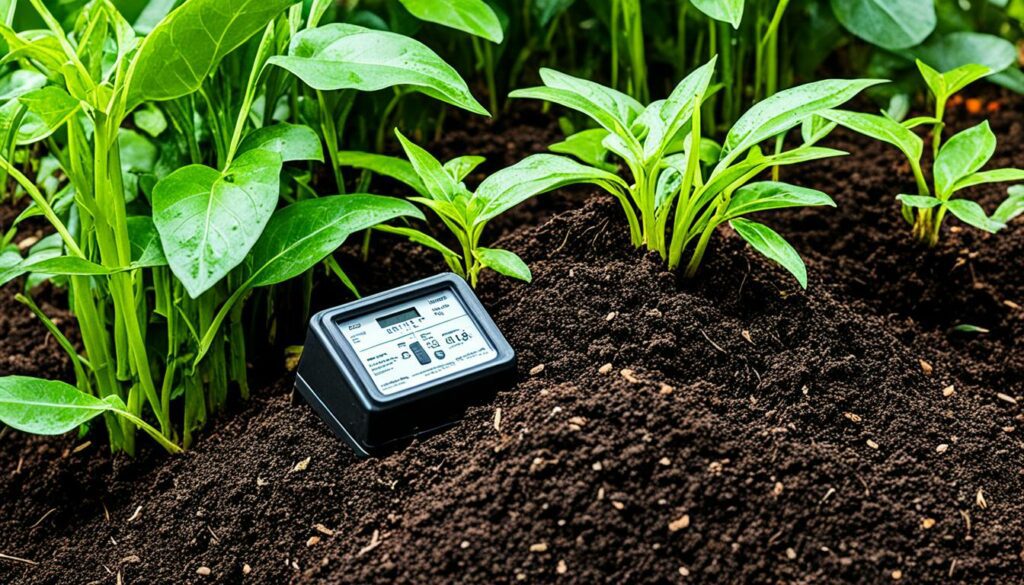
To keep compost moist, you need the best watering skills. The right amount of water for composting is 45% to 60%. This moisture range is perfect for life activities while not drowning the microbes. If it gets too wet, over 65%, it can stop the breakdown process.
Keeping a compost pile moist but not waterlogged is crucial. The ideal moisture content is when a handful of compost feels like a well-wrung sponge.
Check out this table for tips on moisture levels:
| Moisture Content | Condition | Recommendation |
|---|---|---|
| Below 40% | Fungi domination, incomplete decomposition | Add water, high water content materials |
| 35%-44% | Dry and dusty | Add water while mixing, cover pile |
| 45%-60% | Optimal | Maintain regular balanced watering practices |
| Exceeds 65% | Anaerobic conditions | Cover, add dry materials, improve drainage |
Using compost nourishes the soil with valuable nutrients. For every 1% of organic matter, 6 inches of soil gains. This includes 1,000 pounds of nitrogen! Effective water management boosts these benefits, helping plants grow strong and soil stay healthy.
Watering right is good for the compost and nature. It prevents loss of nutrients and keeps soil exchange healthy.
Composting brings many rewards but also some challenges. It’s important to avoid common mistakes. One such mistake is not getting the right mix of brown and green materials. A good rule is to use three parts brown items for every one part green item. This mix helps the compost work better.
It’s key to keep the compost pile warm, between 141°F and 155°F. This temperature range is best for killing off bad bacteria and helping good microbes thrive. Plus, turning the pile often, at least weekly, helps keep air in and speeds up the process.
Staying clear of contaminated compost is a must. Never add diseased plants to your compost. They might spread diseases. Also, don’t overfill your compost bin. It needs space for air to flow and for the contents to break down.
Bad moisture levels can lead to bad smells, loss of nutrients, and slow decomposition. So, it’s vital to water your compost right.
A big mistake is adding kitchen scraps like meat, fish, eggs, and dairy. These can make your compost smell and attract pests. Even some items labelled ‘compostable’ don’t always work well at home. They often need special composting facilities.
Here is a breakdown of key composting mistakes:
| Mistake | Impact | Solution |
|---|---|---|
| Incorrect Brown-Green Ratio | Slow decomposition, unpleasant odours | Use a 3:1 ratio of brown to green materials |
| Not Turning the Pile | Lack of air, slow decomposition | Turn the pile at least once a week |
| Adding Diseased Plants | Could spread disease | Don’t add diseased or infested plants |
| Improper Moisture Levels | Stench, loss of nutrients | Keep the moisture levels right |
| Composting Non-compostable Items | Attracts pests, causes bad smells | Stay away from dairy, meat, fish, and eggs |
By steering clear of these errors and ensuring your compost stays healthy, you can make great compost. This compost will be full of nutrients for your garden.
Microorganisms play a key role in composting. They decompose organic material, boosting the quality of our soil. Learning about the diverse microbes helps us promote a healthy soil environment.
A wide range of microorganisms, like bacteria and fungi, decompose organic matter in compost. Bacteria are the main players, making up 80-90% of the community in compost. Their activity changes with the temperature. Temps from 0 to 40°C see the most action from mesophilic bacteria. Above 40°C, thermophilic bacteria, especially from the Bacillus genus, take charge. The variety of Bacilli is the highest between 50-55°C but diminishes at 60°C and higher.
| Microorganism Type | Role in Composting |
|---|---|
| Mesophilic Bacteria | Initial decomposition at 0-40°C |
| Thermophilic Bacteria | Major decomposition at temperatures above 40°C |
| Actinomycetes | Degrade complex organics like cellulose, lignin, and proteins |
| Fungi | Decompose tough debris once most cellulose is exhausted |
| Protozoa | Feed on bacteria and fungi within water droplets |
| Rotifers | Ingest bacteria and fungi, feed on organic matter |
Actinomycetes and fungi do essential work in compost by breaking down hard-to-digest materials. They work after bacteria consume the cellulose. Protozoa and rotifers play smaller parts but help by eating up bacteria and fungi.
Keeping a good balance in the compost is important. Bacteria are quick to break down organic matter, adding nitrogen to the soil. Good bacteria act as guards against bad ones, keeping our soil healthy.
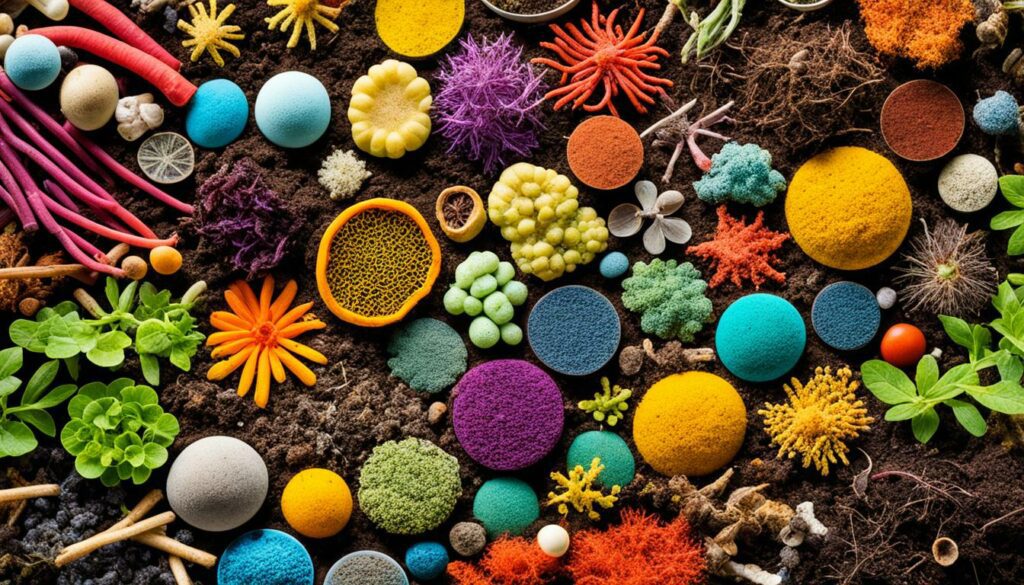
Creating the right conditions for microbes helps us get nutrient-rich compost. This means we rely less on chemicals and our plants grow strong. Understanding the role of each microbe is key to a successful compost and garden.
Creating a composting schedule is key to making top-notch compost. It helps maintain a strong balance in the pile. This is important for the little living things breaking down the materials.
Keeping the compost pile bright and healthy means adding the right stuff on time. For a good mix, use things like fresh grass and veggie scraps (the green stuff). Mix these with brown items like dried leaves and sawdust. Always add as many brown leaves as food scraps to keep the balance right.
It’s also good to turn the pile every so often. This helps add air and spread around moisture. These steps are great for making everything break down faster. Keep an eye on how cool, wet, and fresh the pile is. This is vital to make sure the tiny workers are doing their best job. Also, watch out for bad items that shouldn’t be there, like oily foods or wood that’s been treated.
Choosing the best bin or setup for you is part of the deal. It could be a big backyard box, a tumbler, or something you built yourself. Making the right pick helps your compost system work smoothly. This all leads to getting a lot of great, plant-loving compost for your garden.
| Task | Frequency | Action |
|---|---|---|
| Add materials | Weekly | Alternate layers of green and brown sources |
| Turn pile | Bi-weekly | Ensure even distribution and aeration |
| Monitor moisture | Weekly | Check for dampness, add water if dry |
| Check temperature | Weekly | Maintain optimal range around 140°F |
Stick to this composting schedule to make great use of your compost. By keeping it up and checking on it often, you can enjoy rich, healthy compost. This compost will make your soil stronger and help your garden grow better.
Adding compost tea to gardening helps soil and plants. Use a 55-gallon barrel to make a big batch. This tea, full of good bacteria, boosts plant growth. It can increase vegetable production by 50% when using worm castings. This info comes from the Cornell Vermicompost Research.
The process to make compost tea is easy but detailed. Start with rainwater for its purity. Mix ingredients like ascorbic acid, liquid kelp, unsulphured molasses, and worm castings in a 50-gallon barrel. This mix helps plants grow strong and absorb nutrients better. You can also add turmeric, cinnamon, or wood ash for specific plants if you like.
Aerate the mix with a wand to add oxygen. This step is key for good bacteria growth. Keep the tea warm, between 55 and 80 degrees, for best results. Using this tea often makes soil healthier. This leads to less water and fewer fertilisers needed.
Compost tea improves various soil types. It makes heavy clay soil looser and helps sand keep moisture. When you spray it on plants, you add beneficial microbes that stop diseases. This is a natural way to fight pests. Always clean your tools well to keep the tea safe and useful.
Composting makes garden soil richer naturally. It adds key nutrients and improves structure. This leads to better water retention and stronger plant growth.
Composting enriches the soil and boosts your garden’s output. It creates nutrient-packed compost. Plus, it helps build a healthy soil home for plants.
For good compost, mix kitchen scraps (‘greens’) with yard waste (‘browns’). This combo ensures a good decay and balance.
Pick a spot that gets some sun and has good air flow. Close to your garden makes it easy to use the compost there.
To control compost heat, aim for around 140 degrees Fahrenheit. This temp kills bad seeds and keeps good bugs working hard.
Turning the pile mixes things well, brings in oxygen, and spreads heat evenly. This helps break down the compost faster.
Composting naturally boosts plant growth and soil life. Unlike chemical fertilizers, it’s safe and supports soil health for the long term.
Put homemade compost on garden beds for a plant nutrient boost. This way, it supports growth and improves the soil.
Keep the compost damp but not soaked. This balance is vital for good decomposition and to avoid over-wetting.
Mistakes to dodge include using items that don’t compost and keeping a good mix of ‘greens’ and ‘browns’. Meat and oily foods are best kept out to prevent pest trouble.
Microbes are vital as they break down materials. They include friendly bacteria, fungi, insects, and worms. They help create compost full of nutrients for your garden.
For a good compost, add materials regularly, turn it often, and check on it. This keeps things moving and makes great compost.
Compost tea is great for plants. It speeds up plant growth, betters the soil, and is a strong natural option in place of chemicals.